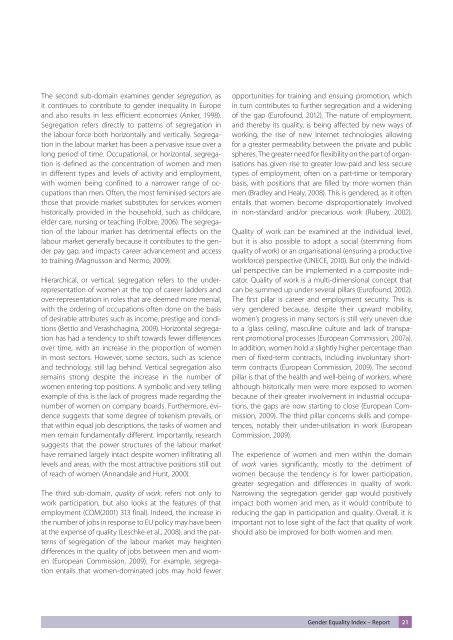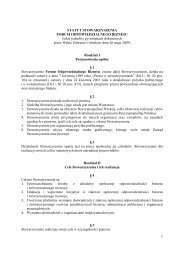Gender Equality Index Report - European Institute for Gender ...
Gender Equality Index Report - European Institute for Gender ...
Gender Equality Index Report - European Institute for Gender ...
You also want an ePaper? Increase the reach of your titles
YUMPU automatically turns print PDFs into web optimized ePapers that Google loves.
The second sub-domain examines gender segregation, as<br />
it continues to contribute to gender inequality in Europe<br />
and also results in less efficient economies (Anker, 1998).<br />
Segregation refers directly to patterns of segregation in<br />
the labour <strong>for</strong>ce both horizontally and vertically. Segregation<br />
in the labour market has been a pervasive issue over a<br />
long period of time. Occupational, or horizontal, segregation<br />
is defined as the concentration of women and men<br />
in different types and levels of activity and employment,<br />
with women being confined to a narrower range of occupations<br />
than men. Often, the most feminised sectors are<br />
those that provide market substitutes <strong>for</strong> services women<br />
historically provided in the household, such as childcare,<br />
elder care, nursing or teaching (Folbre, 2006). The segregation<br />
of the labour market has detrimental effects on the<br />
labour market generally because it contributes to the gender<br />
pay gap, and impacts career advancement and access<br />
to training (Magnusson and Nermo, 2009).<br />
Hierarchical, or vertical, segregation refers to the underrepresentation<br />
of women at the top of career ladders and<br />
over-representation in roles that are deemed more menial,<br />
with the ordering of occupations often done on the basis<br />
of desirable attributes such as income, prestige and conditions<br />
(Bettio and Verashchagina, 2009). Horizontal segregation<br />
has had a tendency to shift towards fewer differences<br />
over time, with an increase in the proportion of women<br />
in most sectors. However, some sectors, such as science<br />
and technology, still lag behind. Vertical segregation also<br />
remains strong despite the increase in the number of<br />
women entering top positions. A symbolic and very telling<br />
example of this is the lack of progress made regarding the<br />
number of women on company boards. Furthermore, evidence<br />
suggests that some degree of tokenism prevails, or<br />
that within equal job descriptions, the tasks of women and<br />
men remain fundamentally different. Importantly, research<br />
suggests that the power structures of the labour market<br />
have remained largely intact despite women infiltrating all<br />
levels and areas, with the most attractive positions still out<br />
of reach of women (Annandale and Hunt, 2000).<br />
The third sub-domain, quality of work, refers not only to<br />
work participation, but also looks at the features of that<br />
employment (COM(2001) 313 final). Indeed, the increase in<br />
the number of jobs in response to EU policy may have been<br />
at the expense of quality (Leschke et al., 2008), and the patterns<br />
of segregation of the labour market may heighten<br />
differences in the quality of jobs between men and women<br />
(<strong>European</strong> Commission, 2009). For example, segregation<br />
entails that women-dominated jobs may hold fewer<br />
opportunities <strong>for</strong> training and ensuing promotion, which<br />
in turn contributes to further segregation and a widening<br />
of the gap (Eurofound, 2012). The nature of employment,<br />
and thereby its quality, is being affected by new ways of<br />
working, the rise of new Internet technologies allowing<br />
<strong>for</strong> a greater permeability between the private and public<br />
spheres. The greater need <strong>for</strong> flexibility on the part of organisations<br />
has given rise to greater low-paid and less secure<br />
types of employment, often on a part-time or temporary<br />
basis, with positions that are filled by more women than<br />
men (Bradley and Healy, 2008). This is gendered, as it often<br />
entails that women become disproportionately involved<br />
in non-standard and/or precarious work (Rubery, 2002).<br />
Quality of work can be examined at the individual level,<br />
but it is also possible to adopt a social (stemming from<br />
quality of work) or an organisational (ensuring a productive<br />
work<strong>for</strong>ce) perspective (UNECE, 2010). But only the individual<br />
perspective can be implemented in a composite indicator.<br />
Quality of work is a multi-dimensional concept that<br />
can be summed up under several pillars (Eurofound, 2002).<br />
The first pillar is career and employment security. This is<br />
very gendered because, despite their upward mobility,<br />
women’s progress in many sectors is still very uneven due<br />
to a ‘glass ceiling’, masculine culture and lack of transparent<br />
promotional processes (<strong>European</strong> Commission, 2007a).<br />
In addition, women hold a slightly higher percentage than<br />
men of fixed-term contracts, including involuntary shortterm<br />
contracts (<strong>European</strong> Commission, 2009). The second<br />
pillar is that of the health and well-being of workers, where<br />
although historically men were more exposed to women<br />
because of their greater involvement in industrial occupations,<br />
the gaps are now starting to close (<strong>European</strong> Commission,<br />
2009). The third pillar concerns skills and competences,<br />
notably their under-utilisation in work (<strong>European</strong><br />
Commission, 2009).<br />
The experience of women and men within the domain<br />
of work varies significantly, mostly to the detriment of<br />
women because the tendency is <strong>for</strong> lower participation,<br />
greater segregation and differences in quality of work.<br />
Narrowing the segregation gender gap would positively<br />
impact both women and men, as it would contribute to<br />
reducing the gap in participation and quality. Overall, it is<br />
important not to lose sight of the fact that quality of work<br />
should also be improved <strong>for</strong> both women and men.<br />
<strong>Gender</strong> <strong>Equality</strong> <strong>Index</strong> – <strong>Report</strong><br />
21

















